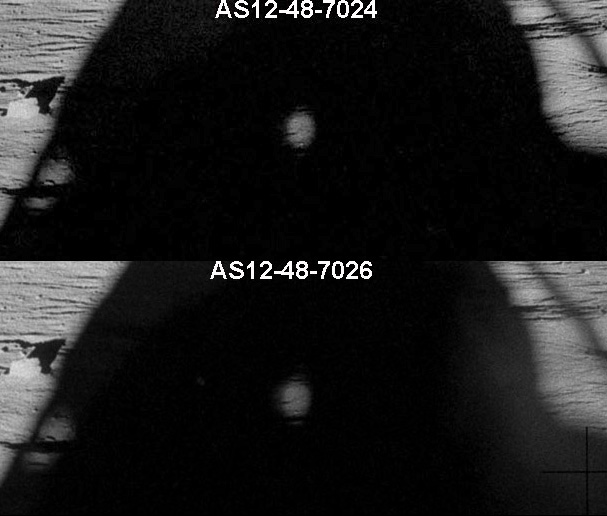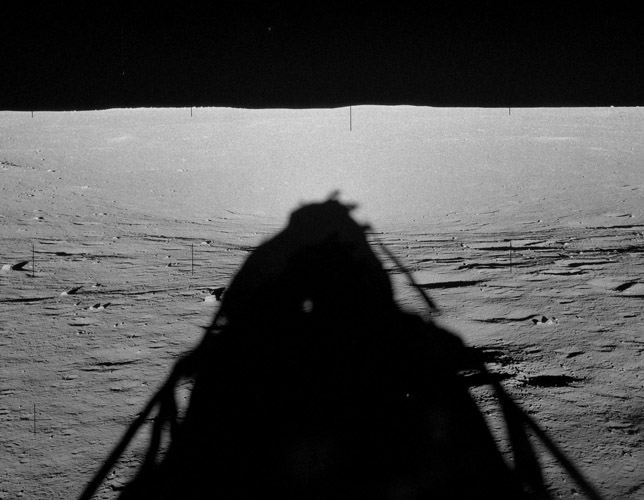
| Journal Home Page | Apollo 12 Journal |
LM Interstage Light Path
Copyright © 2009 by Eric
M. Jones.
All rights reserved.
Last revised 10 June 2014.
Introduction
Journal Contributor Yuri Krasilnikov notes that Apollo 12 post-landing photos AS12-48-7024 and 7026 shows a bright spot near the vertical centerline of the LM shadow and roughly coincident with the transition from the portion of the shadow cast by the Ascent Stage and the portion cast by the Descent Stage. The bottom of the shadow cast by the plume deflector just outside the LMP's window on the right, gives a rough indication of the boundary between the two stages.Cropped version of AS12-48-7024. Frame 7026 is quite similar. The bright spot is at about the same distance out from the LM and the bottom of the plume deflector shadow on the right. Note that the LM is rotated right, with the entire LM shadow more or less in front of Pete and. as can be seen in AS12-48-7028, virtually none of it visible out Al's window. (Click on the image for a full, high-resolution version of 7024.)
Journal Conributor Phil Karn notes that, at high resoltuion, the bright
spot seen in both images proves to be a sunlit patch of lunar surface
containing portions of two small craters and at least one small rock.

High-resolution details from AS12-7024 and 7026 showing the sunlit patch of lunar surface. Note that Photoshop Elements has been used to enhance shadows in the 7024 detail by 25 percent. The sunlit patch includes about half of a small crater on the left, most of another small crater at the bottom, and a small rock (pebble?) just beyond the shadowed portion of the crater nearer the LM.
LM Orientation and Solar Elevation
The two photos were taken at some time between about 112:22:00 and 113:06:00, which are 0844 and 0930 GMT/UTC on 19 November 1969. At those times, the Sun was 6.4 and 6.8 degrees, respectively, above the eastern horizon. The spot is about the same distance out from the LM as the top of the descent stage shadow. The main body of the stage is 3.23 meters tall and, with the Sun between 6.4 and 6.8 degrees above the horizon, the top of the descent stage shadow is between about 29 and 27 meters.As indicated on page 4-23 in the Apollo 12 Mission Report, after coming to rest on the lunar surface, the LM was pitched up (titled back) by 3 degrees and rolled (leaning) left 3.8 degrees. Consquently, the cabin floor was tilted down toward the back and toward Pete's side. The LM was also yawed right (rotated clockwise around the vertical axis) far enough that the entire LM shadow was in front of Pete and, as can be seen in AS12-48-7028, virtually none of it was visible out Al's window. As can be seen in 7024 (at the top of the page), the shadow of the plume deflector just outside Al's window is lined up the the shadow of the north landing strut. Using a reasonably accurate LM model, we can estimate that a yaw of about 10 - 15 degrees will produce that shadow alignment.
Possible Light Paths
1. Reflection off some part of the LM
2. Path thru both the Rendezvous Window and the Commander's front Window
3. Path between the two LM Stages
With the Sun behind the LM, only about
10 to 15 degrees off the center line, and the spot of light near the
centerline of the shadow, the reflecting surface would have to to be
flat or very slightly concave, located on the Commander's (south) side
of the spacecraft and oriented on a line 5 to 7.5 degrees north of
east. There don't appear to be any good candidates.
2. Path thru both the Rendezvous Window and the Commander's front Window
This path is not a viable source of the
bright spot for two reasons. First, taller LM structures aft of
the window keep it in shadow unless the Sun is more than about 35
degrees above the horizon. Second, a line passing through both
windows strikes the ground no more than about 6 meters beyond the west
footpad. See page 20 in Scott Sullivan's superb book, Virtual LM.
3. Path between the two LM Stages
| Journal Home Page | Apollo 12 Journal |
